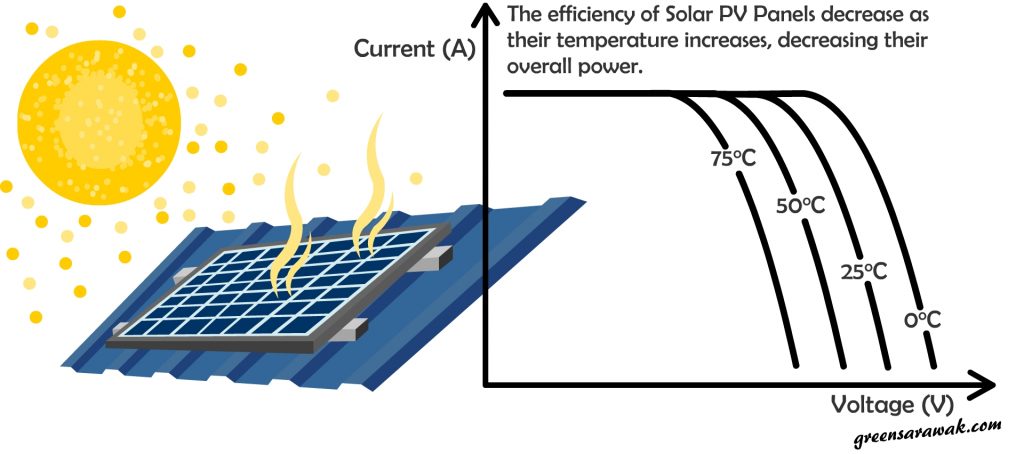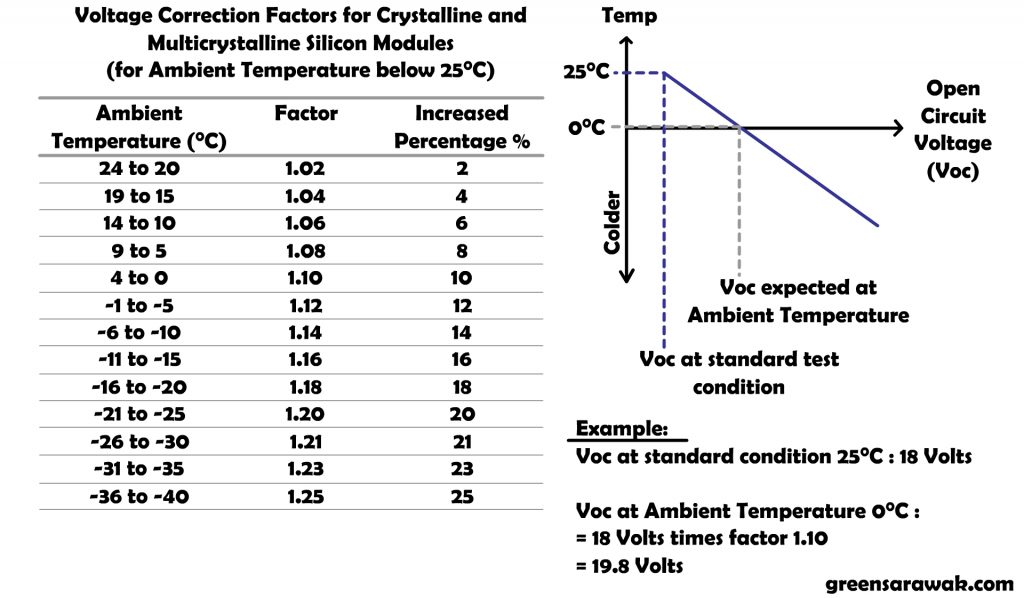Performance of solar PV under different temperatures
Different type of solar PV cells have different response to heat. All the panels are tested at 25 degree celcius with 1000 Watt per Meter Square irradience (as in Standard Test Condition). Hence the actual output of the panel can varies from the power rating stated on the panels.
You might encounter a term temperature coefficient or commonly maximum power temperature coefficient (Pmax.). It tells you how much power the panel will lose (due voltage drop) in percentage when the temperature rises by 1°C above 25°C (which is the Standard Test Condition). However if the temperature is lower than 25°C , for every 1°C below 25°C, the calculation will be reverse, as the cooler the more power gain (due voltage gain) in compare to standard test condition.
Silicon PV have higher temperature coefficient of about -0.4 to -0.5 percent (losing 0.4% – 0.5% of power output, evidence by a voltage drop) for every degree Celsius increase in temperature above 25 degree Celsius, if compared to some thin film which has lower temperature coefficient of about -0.2 to -0.3 . It means in colder temperature, below the standard 25 degree Celsius , the solar PV cells will have increased efficiency. (Similar to why extreme cooling like liquid nitrogen cooling can make a CPU overclocked to an extreme high functional frequency.) Monocrystalline solar panels can tolerate heat better than Polycrystalline solar panels.

Solar PV loves cool weather. In cold winter, it can generate more voltage than what is rated on the panels. Hence it is important to know what is the coldest temperature in your area and adjust the potential accordingly. You might need a Inverter than can handle higher voltage and power to prevent it to be overloaded during winter months. Even though the panels can be very efficient and generates more power than summer, however the Sun Hours of winter is much shorter, which offsets its benefits.

Since each silicon panels can be manufactured differently depends on proprietary technology, the best way to determine the temperature coefficient of the panel in hand is to look at the manufacture’s datasheet.
It is kind of irony that the sun light that we want for solar PV cells to capture and generate heat also comes with unwanted infrared heat which heat up the panels. At 45 degree Celsius during a hot sunny day, the solar PV panels can have reduced efficiency up to 10%.
Sun light spectrum is not just all useful
At Earth surface, the Sun Light is consist of approximately 2% of Ultra Violet Light, 49% of Visible light, and 49% of Infrared Light. Although UV light is known to cause skin burns and damage to infrastructure, our friendly Ozone at the Stratosphere had help us filter most of them , leaving 2% UV escaped to the surface, higher if there is hole in the Ozone. 49% of visible light can heat up surfaces, but we need them for visibility, photosynthesis and photovoltaic. The other 49% of invisible infrared spectrum is spread across spectrum of 700nm to 2500nm, is a broad spectrum that not easy to filter them off completely, even with the best solar film that claims to filter off infrared spectrum. They heat up surface very well and responsible for a hot sunny day. The clouds and water molecule in the atmosphere helps allot in reducing them, creating cool cloudy days but also reduce some visible light.
The heating panels
Some might think that, the outside temperature is cool at 25°C , should we be worry ? In fact, the temperature of the panel that facing the sun is all different story. Remember how you car inside cooked up to nearly 60°C while outside only merely a 25°C sunny day ? It is a same scenario when comes to Solar PV panels.
Glass is a good thermal insulator, which means heat will not move freely between them. Hence the heat will be easily trap on the other side (back) of the panels. Moreover some of the light will be converted into heat while passing the glass, which produce more heat. Heat will be even more increased with the nature of the solar PV cells which is dark in color, as dark object absorb more heat. In the end the solar PV cells can be running at much higher temperature than the atmospheric temperature.
With a sunny day of 25°C atmospheric condition, the panels might running at 50°C at the solar PV cell level if the back of the panel is not cooled.
Cooling your panels
You can’t shade the solar PV panels to prevent it to be overheating, but several simple steps can help to reduce the heat trapping on the solar cells.
You will need to leave few inches (preferably 6 inch or more) below the solar panel for better air circulation that cools the panel naturally. It is very important for those who want to have a fixed solar PV panels on their roof tops. In hot sunny day, some of the roof can heat up to 45-75 Celsius if it is a poorly ventilated roof. If the spacing between the panels and roof is too narrow, lack of ventilation can cause extreme heat that reduce the efficiency of the solar PV panels. You can use a thermal imagery to visualize the hot spots of your solar PV system.
Another approach is active cooling of solar PV cells during hot weather. Some manage to have significant improvement in solar PV efficiency by placing water sprinkle and water cooling system on the panels. Another alternative is building a floating Solar PV farm over water body such as rivers, canals and lakes. The evaporation of water will help to reduce the heat of the panels.
NEXT CHAPTER >> Know the effect of partial shading
